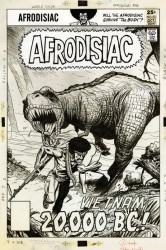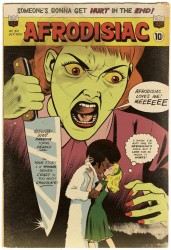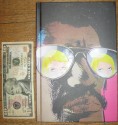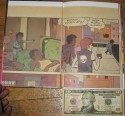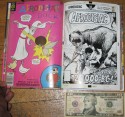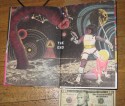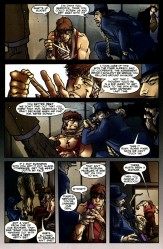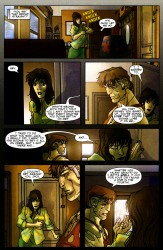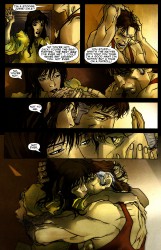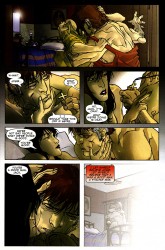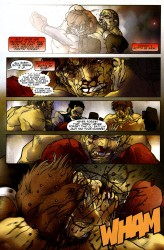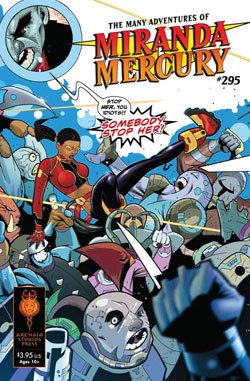
7 Things About Yotsuba&! 7
January 6th, 2010 Posted by david brothers
I grew up around a small battalion of cousins. I was part of the first wave, and we had around seven years before the next group came through. Even now, I’ve got a younger brother who’s a year old, and if I didn’t live all the way across the country, I’m sure I’d still be in the thick of it. So, a lot of stuff in Kiyohiko Azuma’s Yotsuba&! is old hat to me. Only, it’s funny now, because I’m not being shanghai’d into watching someone else’s kid or changing diapers. I can appreciate it for what it is, rather than wishing I was outside on my bike instead of watching some rugrat drool all over the place.
I read the 7th volume in December and loved it. My complaints about the translation still stand, but that’s a difference of opinion. The source material is incredibly strong, from art to writing, and it shows in the translation. Yotsuba&! is the kind of book that you makes you bark laugh, or snort, or guffaw, or whatever embarrassing laugh it is people hate to do these days. When you read Yotsuba&!, you’re going to like it. That’s just the way things work. It’s natural. I read Yotsuba&! 7 while going through hell at work. Bad day after bad day, coming home pissed off, so on and so forth. But, Yotsuba&! was a bright spot. It’s the kind of book that cheers you up, if only for a little bit, and is more than welcome due to that fact.
I picked out seven things I liked from this volume of Yotsuba&!. I don’t know that they’re the seven funniest things, but they are things that I think encapsulate what Yotsuba&! is all about. They range from comedy to craft to characters, all from volume 7. This is a good volume to pull from, being both the latest and blisteringly funny, to boot. There’s a couple pages in there that kill me every time I look at them.
(After you read this, read this. Azuma won the Excellence Prize in manga at a 2006 media festival and gave an acceptance interview. It’s pretty interesting and well worth a read. Thanks to Jog for finding it.)
 Yotsuba&Mundanity
Yotsuba&Mundanity
Real life is mundane. When I wake up in the morning, I calculate whether or not I can sleep several more hoursminutes, figure out what time I finally fell asleep, and then get out of bed, landing on the wrong side. I brush my teeth with my eyes closed, pull on clothes, and hit the streets. Have you ever seen a little kid wake up? No, you haven’t, because they wake up before we do, with three times as much energy.
I like the body language in this panel, with Koiwai and Yotsuba both brushing their teeth the same way, but looking completely different at the same time. Yotsuba is wide-eyed and alert, while Koiwai is still sleepy. It’s not too hard to see that Koiwai probably taught her how to brush her teeth, judging from their posture, but the difference between the two speaks volumes. To Yotsuba, every action, every event, is something to be devoured. To Koiwai, it’s just another morning.
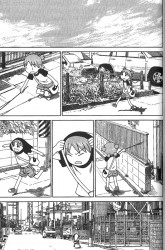 Yotsuba&Real Life
Yotsuba&Real Life
The attention to clothes in Yotsuba&! is lovely. Characters don’t just wear Generic [Color] Shirt and Straight Slacks. Clothes have patterns, jeans look like jeans, and people actually look like they pay attention to what they put on in the morning. Yotsuba and the girls next door all wear age appropriate material, from an adorable shirt with a bunny on the front on Yotsuba to classy sweaters and skirts on the eldest girl. Even Koiwai, who spends most of each volume in boxers and a white t-shirt, makes sense when he goes out. If all you did all day was type at a computer at home, you’d do the same. (Don’t front. I know several pro bloggers and none of y’all wear pants, except when someone asks you to.)
What’s nice about Yotsuba&! are these occasional interludes where Azuma just lets Yotsuba roam freely around the area. Part of it is that I like seeing him being able to break out of the tiny panels that made up his Azumanga Daioh work and really go at a panel. There’s some photoref going on, but the way his cartoony characters interact with their environment is always golden. Yotsuba never sleeps straight. She’s always sprawled or draped over something. Falling asleep partially draped over a table with cup phones wrapped around her body? It looks good and it fits her personality.
But the best is just seeing Yotsuba roam and the things she does. Everything focuses down onto the most important part of Yotsuba&!, which is that everything is wonderful if you look at it with the right eyes. A walk to the store isn’t just ten minutes of walking. It’s strolling past neat bushes, finding a cool stick, making noise (everyone who has ever seen a kid make noise just to make noise raise your hand), and, when all that becomes boring, turning yourself into an airplane and flying along.
There is a purity in Yotsuba that I can appreciate. A lot of the appeal of the series is that she isn’t tainted by the things that make adults bitter and mean. Everything is new, everything is wonderful, and Yotsuba is in the perfect position to appreciate all of it. And, by seeing the world through her eyes, we can appreciate it, as well.
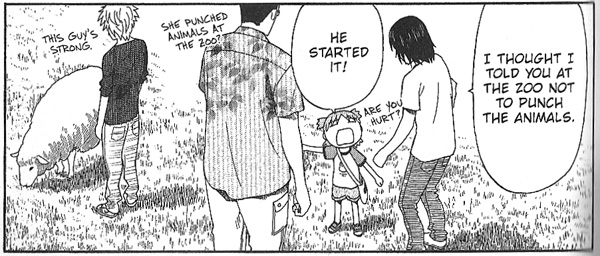
Yotsuba&Comedy
Sometimes, man, Yotsuba&! is just funny. Yotsuba runs afoul of a sheep, gets knocked down, hops up, and hits the sheep with a hook. That’s comedy. The cherry on top is that this is apparently not just a one time thing- she makes a habit of punching animals.
 Yotsuba&Cartooning
Yotsuba&Cartooning
Yotsuba trying to decide what to put back at the story, and putting all five years of her experience toward figuring out her dilemma, is another good scene. This one shows Azuma’s skill at cartooning. Yotsuba goes from listening intently in panel two, paying close attention, to carefully examining the goods, to realizing that she can’t put anything back because she needs all of it, before being told a possible solution that she hadn’t even thought of, and then she’s determined.
I really like this progression. Azuma gets a lot across with not a lot of lines, particularly in the fourth panel, where Yotsuba’s practically in agony over having to make a hard decision. His realistic approach to clothes and backgrounds gives way when it serves the story, turning faces into two circles and a line. It’s easy to overdo, hard to get right, but Azuma tiptoes on that line with a deft touch. Yotsuba is the most expressive, but her expressiveness tends to infect other characters in a believable way. Her nature encourages other people to turn child-like, like when Yotsuba and Koiwai have giant monster battles.
 Yotsuba&Focus
Yotsuba&Focus
One of my favorite things is when a little kid gets super fixated on something. I have a cousin who loves to play video games. I made the mistake of showing him the Wii at an early age, and he was the first one that wasn’t dumb enough to fall for the old “give a kid the controller, leave it unplugged, pretend like it’s two player” trick. After that, it was on. Wii, GameBoy, Xbox, whatever, he was all about it. He was really into Rayman Raving Rabbids for a while, and it got to where you couldn’t mention anything that even sounded like Wii or Rayman or Rabbits without him peeking around the corner like, “Are we about to play Wii?” He knew what he wanted and anything that brought him close to that was a good thing.
That’s a big part of why I like this scene in Yotsuba&! 7. Yotsuba doesn’t know what a patissier is, but she knows that chefs cook food, and food is hamburgers, so Fuuka is… going to cook hamburgers! Duh! It’s obvious! Of course, when Fuuka reveals that she is going to make a cake, Yotsuba loses it and declares her undying love on the next page. That’s the other thing about kids. Show them the next awesome thing, or another awesome thing, and they’re ready to go, they don’t even have to switch gears.
And once again, through Yotsuba’s eyes, everything is magical. I’m a big fan of hamburgers, but I don’t think I get as excited as Yotsuba does over them. We might be equal on cake, though.
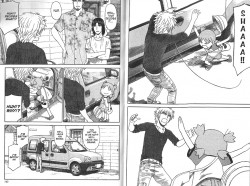
Yotsuba&CrossCutter
In terms of calling shotgun, Cross Cutter beats all. Right, Heidern?
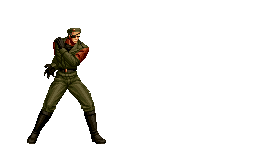
Right.
Yotsuba’s “Hmph!” in the second panel on the second page is amazing. That’s Azuma’s cartooning at work again, using a little to accomplish a lot. It getting an entire panel to itself is a deft touch, giving the comedy a chance to breathe. We’re right there with Yanda, wondering “Did that just happen?”
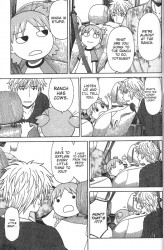
Yotsuba&Yanda
Yotsuba is adorable, but she’s also a smug jerk. She’s just so matter of fact and condescending on this page. Why else would you go to a ranch, but for the cows? C’mon Yanda, you’re dumb. The little fist pump in panel five like “So there!” would make it if not for panel 7 and the look on her face. That panel kills me every time.

